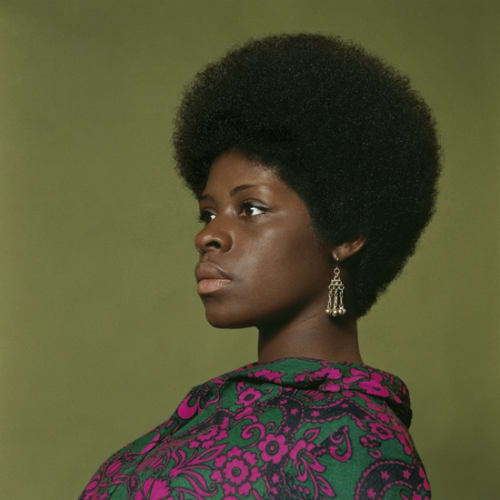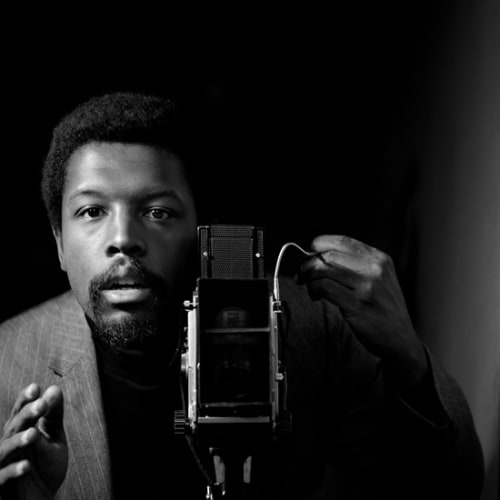“The phrase ‘black is beautiful’ referred to a broad embrace of black culture and identity. It called for an appreciation of the black past as a worthy legacy, and it inspired cultural pride in contemporary black achievements.” – National Museum of African American History and Culture
Kwame Brathwaite (b. 1938, Brooklyn, New York) was an early champion of the “Black is Beautiful” movement. Beginning in the late 1950s, his photography, organizing and promoting helped create momentum for the slogan which gained prominence through the 60s and 70s. Now through September 6, the Columbia (South Carolina) Museum of Art shares his striking images and little-known story during “Black is Beautiful: The Photography of Kwame Brathwaite,” the first exhibition dedicated to his career.
“When we planned on taking this exhibition in 2018, what was so exciting was the story that was being told–I don’t want to say for the first time, but this is not a well-known story even within the black community–we love opportunities to refresh art history, to tell new stories, and this one is so dynamic,” CMA curator Catherine Walworth told Forbes.com.
Brathwaite’s story encompasses more than his photographs.
Along with his older brother, Elombe Brath, he founded the African Jazz Arts Society and Studios (AJASS), a collective of creatives across multiple disciplines. They also founded the Grandassa Models in 1962, a modeling agency for black women challenging white beauty standards. “Grandassa” is taken from the term “Grandassaland,” the name black nationalist Carlos Cooks used to refer to Africa.
“He and brother were teens when they formed AJASS with friends from high school,” Walworth said. “This was a creative movement by young people who were politically engaged, who were immersed in the conversations of the day, and were looking for a way to effect change within their own community.”
That desire strikes a familiar chord today with millions of Americans searching for their role in the country’s current reckoning with racial injustice, white supremacy, environmental degradation, economic inequality, disparities in health care–a broad spectrum of societal ills which have come to the forefront in 2020 like never before.
“It’s a reminder for us right now that there are different ways to be proactive,” Walworth said. “I think that each of us inside ourselves are struggling with what should we be doing right now; Kwame and his brother and his friends show us examples of ways where they carved out what they wanted to do and how they wanted to effect change.”
The exhibit does not, however, stand only upon its activism.
“This exhibition importantly does two things: it continues the conversation (of racial equality) by bringing up a really historically interesting and creative and important example from the past, but it’s so beautiful–we are also in need of refreshment of ourselves and of our souls–it is doing both those things,” Walworth said. “If you come and see the exhibition you are still being immersed in the conversation, but you are also taking care of yourself.”
The exhibition covers roughly the first 10 years of Brathwaite’s career, “when this was about black artists making a change for their black community, predominantly, and not listening to a lot of outside voices,” according to Walworth. By the 70's, Brathwaite’s star had risen and he was one of the top concert photographers, shaping the images of such public figures as Stevie Wonder, Bob Marley and James Brown.
The photos on view largely come from Brathwaite’s personal archive.
“You start off with these smaller black and white photos which are beautiful and then as you progress through the exhibition, the final gallery are these massive, five-feet-square color photographs that just overwhelm your senses,” Walworth said. “I think that for audiences who love photography, this exhibition is very special in that you get major shifts in scale, you get both black and white and color photographs, but for people who are of a younger demographic who are used to digital photographs, this is a lesson in the art of capturing the moment and a very living moment in one shot.”
Crates with exhibition material arrived at the CMA March 11, days before the museum shut down. It was one of the first in the nation to reopen. A decision welcomed by the community.
“It had the feeling of Thanksgiving about it,” Walworth said of the museum’s reopening and debut of “Black is Beautiful.” “People were happy to see people again–we are enacting every safety measure that you can–but still, just to see people coming in and the responses that we’re getting from the community are so positive.”
While art institutions across the United States ask themselves how to be more welcoming to the black audiences they have consciously or unconsciously ignored previously, the most obvious answer is to show more black artists portraying more black subjects. For decades, people of color could walk through the galleries at even the nation’s greatest art museums and not find a single painting or sculpture which looked like them. That problem has only begun to be seriously discussed and addressed across the sector in recent years.
With “Black is Beautiful,” the CMA found a new, large audience waiting to be addressed.
“The opening weekend was gorgeously warm, and I would say almost all of our visitors were from our African-American community,” Walworth said. “People have told us that they want to see more black artists, that this show was fantastic for them, that they came out specifically because this was focused on black artists.”
“Black is Beautiful” comes on the heels of shows at the CMA centered on the work of van Gogh last fall and vintage horror movie posters this winter. Each show appealing to a different demographic.
The museum couldn’t have anticipated how the show’s subject matter would directly reflect the nation’s most pressing societal debate when it began planning for the exhibition two years ago, that was a stroke of curatorial good fortune.
“We’re serving the community in a way that we need and want to be right now, but we had just thought, at the time, this was going to be a fantastic summer exhibition and we were part of a landmark tour,” Walworth said.
What was not mere good fortune was how this show reflects the CMA’s updated experience promises among which are to be welcoming, “allowing everyone to see themselves portrayed in the museum and their human experience be reflected upon,” as Walworth says, and a desire to broaden what visitors see inside their museum, “there’s still so much art history to tread over, it doesn’t all have to be Picasso exhibitions over and over.”
The exhibition, organized by the Aperture Foundation, travels to New York and Winston-Salem, North Carolina following it’s time in Columbia.


